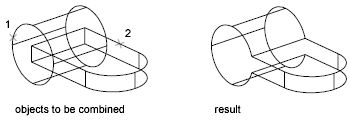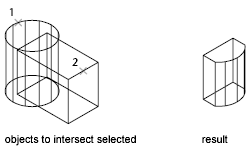Create composite 3D objects by combining, subtracting, or finding the intersecting mass of two or more 3D solids, surfaces, or regions.
Composite solids are created from two or more solids, surfaces, or regions through any of the following commands: UNION, SUBTRACT, and INTERSECT.
3D solids record a history of how they were created. This history allows you to see the original forms that make up composite solids.
Methods for Creating Composite Objects
Three methods are available for creating composite solids, surfaces, or regions:
-
Combine two or more objects.
With UNION, you can combine the total volume or area of two or more objects.

-
Subtract one set of solids from another.
With SUBTRACT, you can remove the common volume or area of one set of objects from another. For example, you can use SUBTRACT to create holes in a mechanical part by subtracting cylinders from the object.

-
Find the common volume.
With INTERSECT, you can create a composite object from the common volume or area of two or more overlapping objects. INTERSECT removes the portions that do not overlap and creates a composite object from the remainder.

Create Composites from Mixed Object Types
In addition to creating composite objects from the same object types, you can also create composites from mixed surfaces and solids.
- Mixed intersections. Combining a solid and a surface through intersection results in a surface.
- Mixed subtractions. Subtracting a 3D solid from a surface results in a surface. However, you cannot subtract a surface from a 3D solid object.
- Mixed unions. You cannot create a union between 3D solid and surface objects.
You cannot combine solids with mesh objects. However, you can convert them to 3D solids in order to combine them with solids.
If a selection set of mixed objects contains regions, the regions are ignored.